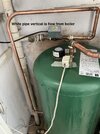The old cylinder is in the car and ready to go to scrap on Tuesday - I expect to get £100 for it which is niceIf the HW is gravity now, it will still be gravity until you alter things and convert to fully pumped. But fully pumped won't be a problem with increased pressure, if that's what you're concerned about. Though looking at it again - are you sure it is currently gravity HW? Doesn't the pipe that the HW tees off feed the rads? If it were gravity I'd expect dedicated pipes from the boiler to the coil. Not that it makes any difference to your plans.
I trust you'll weigh it in for scrap! Don't leave it outside or it will disappear.
I have one flow pipe coming in which then tees off at the airing cupboard for hot water with a 2 port control valve - The return from the hot water cylinder is dedicated. If hot water is met the flow goes around the radiator bypassing the hot water tee and return.
I do not know if that makes it a gravity hot water system



